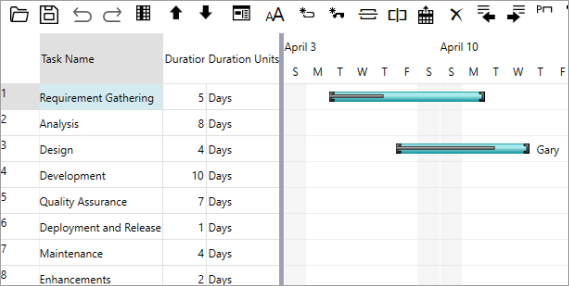Task Resources
GanttView supports three kinds of resources namely work, material, and cost as described in the following table:
| Resource Type | Description |
|---|---|
| Work Resource | Refers to the people and equipment required to accomplish a set of tasks defined in a project. |
| Material Resource | Refers to the exhaustible raw material and goods required to accomplish a set of tasks in a project. |
| Cost Resource | Refers to the financial cost associated to a task that needs to be accounted for in a project such as expenditures on travel, entertainment, and other overheads. |
The following image shows a resource named "Gary" assigned to a task in GanttView.

Add Resource
GanttView provides the Resource class for handling resources. To create and manage resources, you need to create an instance of the Resource class and set its name and cost using Name and Cost properties, respectively. Besides, you can use ResourceType property of the Resource class which uses the ResourceType enumeration to set the resource type.
The Resources class provides Add method to add the resources to a locally-defined resource dictionary. However, simply creating a resource is of no use until it is assigned to a task for which the GanttView control provides the ResourceRef class.
The following code example illustrates creating and adding a resource and, then assigning a task to it. This example uses the sample created in Quick Start.
//Creating a resource
Resource r = new Resource();
r.ResourceType = ResourceType.Work;
r.Name = "Gary";
r.Cost = 300m;
//Adding the resource to GanttView
gv.TaskResources.Add(r, "Gary");
//Assigning the resource to task 't1'
Task t1 = gv.Tasks.Search("Requirement Gathering");
if (t1 != null && t1.ResourceRefs.Count == 0)
{
ResourceRef rRef = new ResourceRef();
rRef.Resource = r;
rRef.Amount = 0.5;
t1.ResourceRefs.Add(rRef);
}


